
clearml-fractional-gpu
ClearML Fractional GPU - Run multiple containers on the same GPU with driver level memory limitation ✨ and compute time-slicing
Stars: 56
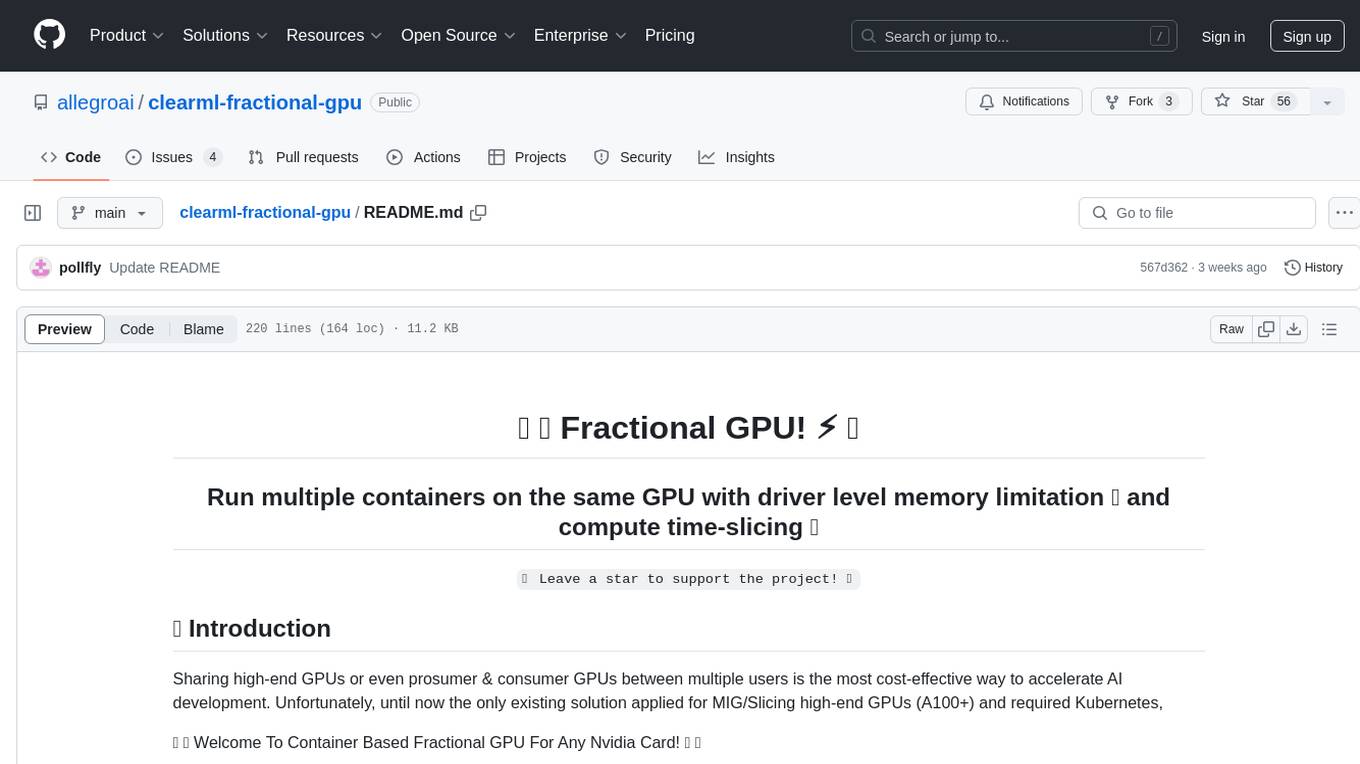
ClearML Fractional GPU is a tool designed to optimize GPU resource utilization by allowing multiple containers to run on the same GPU with driver-level memory limitation and compute time-slicing. It supports CUDA 11.x & CUDA 12.x, preventing greedy processes from grabbing the entire GPU memory. The tool offers options like Dynamic GPU Slicing, Container-based Memory Limits, and Kubernetes-based Static MIG Slicing to enhance hardware utilization and workload performance for AI development.
README:
Run multiple containers on the same GPU with driver level memory limitation ✨ and compute time-slicing 🎊
🌟 Leave a star to support the project! 🌟
Sharing high-end GPUs or even prosumer & consumer GPUs between multiple users is the most cost-effective
way to accelerate AI development. Unfortunately, until now the
only existing solution applied for MIG/Slicing high-end GPUs (A100+) and required Kubernetes,
🔥 🎉 Welcome To Container Based Fractional GPU For Any Nvidia Card! 🎉 🔥
We present pre-packaged containers supporting CUDA 11.x & CUDA 12.x with pre-built hard memory limitation! This means multiple containers can be launched on the same GPU, ensuring one user cannot allocate the entire host GPU memory! (No more greedy processes grabbing the entire GPU memory! Finally we have a driver level hard limiting memory option).
ClearML offers several options to optimize GPU resource utilization by partitioning GPUs:
- Dynamic GPU Slicing: On-demand GPU slicing per task for both MIG and non-MIG devices (available under the ClearML Enterprise plan):
- Container-based Memory Limits (this repository): Use pre-packaged containers with built-in memory limits to run multiple containers on the same GPU (available as part of the ClearML open source offering).
- Kubernetes-based Static MIG Slicing: Set up Kubernetes support for NVIDIA MIG (Multi-Instance GPU) to define GPU fractions for specific workloads (available as part of the ClearML open source offering).
With these options, ClearML enables running AI workloads with optimized hardware utilization and workload performance. This repository covers container-based fractional GPUs. For more information on ClearML's fractional GPU offerings, see the ClearML documentation.
Pick the container that works for you and launch it:
docker run -it --gpus 0 --ipc=host --pid=host clearml/fractional-gpu:u22-cu12.3-8gb bashTo verify fraction GPU memory limit is working correctly, run inside the container:
nvidia-smiHere is an example output from A100 GPU:
+---------------------------------------------------------------------------------------+
| NVIDIA-SMI 545.23.08 Driver Version: 545.23.08 CUDA Version: 12.3 |
|-----------------------------------------+----------------------+----------------------+
| GPU Name Persistence-M | Bus-Id Disp.A | Volatile Uncorr. ECC |
| Fan Temp Perf Pwr:Usage/Cap | Memory-Usage | GPU-Util Compute M. |
| | | MIG M. |
|=========================================+======================+======================|
| 0 A100-PCIE-40GB Off | 00000000:01:00.0 Off | N/A |
| 32% 33C P0 66W / 250W | 0MiB / 8128MiB | 3% Default |
| | | Disabled |
+-----------------------------------------+----------------------+----------------------+
+---------------------------------------------------------------------------------------+
| Processes: |
| GPU GI CI PID Type Process name GPU Memory |
| ID ID Usage |
|=======================================================================================|
+---------------------------------------------------------------------------------------+
| Memory Limit | CUDA Ver | Ubuntu Ver | Docker Image |
|---|---|---|---|
| 12 GiB | 12.3 | 22.04 | clearml/fractional-gpu:u22-cu12.3-12gb |
| 12 GiB | 12.3 | 20.04 | clearml/fractional-gpu:u20-cu12.3-12gb |
| 12 GiB | 11.7 | 22.04 | clearml/fractional-gpu:u22-cu11.7-12gb |
| 12 GiB | 11.1 | 20.04 | clearml/fractional-gpu:u20-cu11.1-12gb |
| 8 GiB | 12.3 | 22.04 | clearml/fractional-gpu:u22-cu12.3-8gb |
| 8 GiB | 12.3 | 20.04 | clearml/fractional-gpu:u20-cu12.3-8gb |
| 8 GiB | 11.7 | 22.04 | clearml/fractional-gpu:u22-cu11.7-8gb |
| 8 GiB | 11.1 | 20.04 | clearml/fractional-gpu:u20-cu11.1-8gb |
| 4 GiB | 12.3 | 22.04 | clearml/fractional-gpu:u22-cu12.3-4gb |
| 4 GiB | 12.3 | 20.04 | clearml/fractional-gpu:u20-cu12.3-4gb |
| 4 GiB | 11.7 | 22.04 | clearml/fractional-gpu:u22-cu11.7-4gb |
| 4 GiB | 11.1 | 20.04 | clearml/fractional-gpu:u20-cu11.1-4gb |
| 2 GiB | 12.3 | 22.04 | clearml/fractional-gpu:u22-cu12.3-2gb |
| 2 GiB | 12.3 | 20.04 | clearml/fractional-gpu:u20-cu12.3-2gb |
| 2 GiB | 11.7 | 22.04 | clearml/fractional-gpu:u22-cu11.7-2gb |
| 2 GiB | 11.1 | 20.04 | clearml/fractional-gpu:u20-cu11.1-2gb |
[!IMPORTANT]
You must execute the container with
--pid=host!
[!NOTE]
--pid=hostis required to allow the driver to differentiate between the container's processes and other host processes when limiting memory / utilization usage
[!TIP]
ClearML-Agent users add
[--pid=host]to youragent.extra_docker_argumentssection in your config file
Build your own containers and inherit form the original containers.
You can find a few examples here.
Fractional GPU containers can be used on bare-metal executions as well as Kubernetes PODs. Yes! By using one of the Fractional GPU containers you can limit the memory consumption of your Job/Pod and easily share GPUs without fearing they will memory crash one another!
Here's a simple Kubernetes POD template:
apiVersion: v1
kind: Pod
metadata:
name: train-pod
labels:
app: trainme
spec:
hostPID: true
containers:
- name: train-container
image: clearml/fractional-gpu:u22-cu12.3-8gb
command: ['python3', '-c', 'print(f"Free GPU Memory: (free, global) {torch.cuda.mem_get_info()}")'][!IMPORTANT]
You must execute the pod with
hostPID: true!
[!NOTE]
hostPID: trueis required to allow the driver to differentiate between the pod's processes and other host processes when limiting memory / utilization usage
The containers support Nvidia drivers <= 545.x.x.
We will keep updating & supporting new drivers as they continue to be released
Supported GPUs: RTX series 10, 20, 30, 40, A series, and Data-Center P100, A100, A10/A40, L40/s, H100
Limitations: Windows Host machines are currently not supported. If this is important for you, leave a request in the Issues section
-
Q: Will running
nvidia-smiinside the container report the local processes GPU consumption?
A: Yes,nvidia-smiis communicating directly with the low-level drivers and reports both accurate container GPU memory as well as the container local memory limitation.
Notice GPU utilization will be the global (i.e. host side) GPU utilization and not the specific local container GPU utilization. -
Q: How do I make sure my Python / Pytorch / Tensorflow are actually memory limited?
A: For PyTorch you can run:
import torch
print(f'Free GPU Memory: (free, global) {torch.cuda.mem_get_info()}')Numba example:
from numba import cuda
print(f'Free GPU Memory: {cuda.current_context().get_memory_info()}')-
Q: Can the limitation be broken by a user?
A: We are sure a malicious user will find a way. It was never our intention to protect against malicious users.
If you have a malicious user with access to your machines, fractional GPUs are not your number 1 problem 😃 -
Q: How can I programmatically detect the memory limitation?
A: You can check the OS environment variableGPU_MEM_LIMIT_GB.
Notice that changing it will not remove or reduce the limitation. -
Q: Is running the container with
--pid=hostsecure / safe?
A: It should be both secure and safe. The main caveat from a security perspective is that a container process can see any command line running on the host system. If a process command line contains a "secret" then yes, this might become a potential data leak. Notice that passing "secrets" in the command line is ill-advised, and hence we do not consider it a security risk. That said if security is key, the enterprise edition (see below) eliminate the need to run withpid-hostand thus fully secure. -
Q: Can you run the container without
--pid=host?
A: You can! But you will have to use the enterprise version of the clearml-fractional-gpu container (otherwise the memory limit is applied system wide instead of container wide). If this feature is important for you, please contact ClearML sales & support.
The license to use ClearML is granted for research or development purposes only. ClearML may be used for educational, personal, or internal commercial use.
An expanded Commercial license for use within a product or service is available as part of the ClearML Scale or Enterprise solution.
ClearML offers enterprise and commercial license adding many additional features on top of fractional GPUs, these include orchestration, priority queues, quota management, compute cluster dashboard, dataset management & experiment management, as well as enterprise grade security and support. Learn more about ClearML Orchestration or talk to us directly at ClearML sales.
Tell everyone about it! #ClearMLFractionalGPU
Join our Slack Channel
Tell us when things are not working, and help us debug it on the Issues Page
This product is brought to you by the ClearML team with ❤️
For Tasks:
Click tags to check more tools for each tasksFor Jobs:
Alternative AI tools for clearml-fractional-gpu
Similar Open Source Tools

clearml-fractional-gpu
ClearML Fractional GPU is a tool designed to optimize GPU resource utilization by allowing multiple containers to run on the same GPU with driver-level memory limitation and compute time-slicing. It supports CUDA 11.x & CUDA 12.x, preventing greedy processes from grabbing the entire GPU memory. The tool offers options like Dynamic GPU Slicing, Container-based Memory Limits, and Kubernetes-based Static MIG Slicing to enhance hardware utilization and workload performance for AI development.
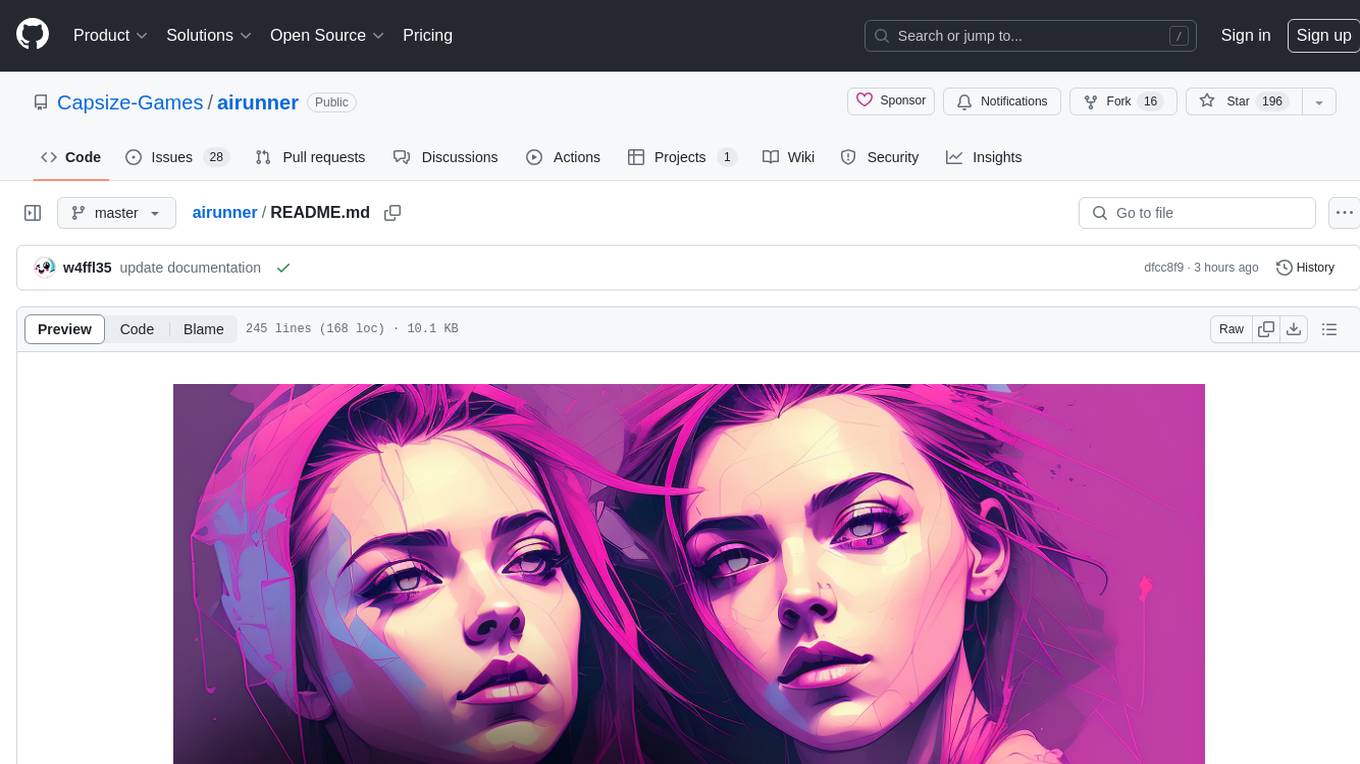
airunner
AI Runner is a multi-modal AI interface that allows users to run open-source large language models and AI image generators on their own hardware. The tool provides features such as voice-based chatbot conversations, text-to-speech, speech-to-text, vision-to-text, text generation with large language models, image generation capabilities, image manipulation tools, utility functions, and more. It aims to provide a stable and user-friendly experience with security updates, a new UI, and a streamlined installation process. The application is designed to run offline on users' hardware without relying on a web server, offering a smooth and responsive user experience.
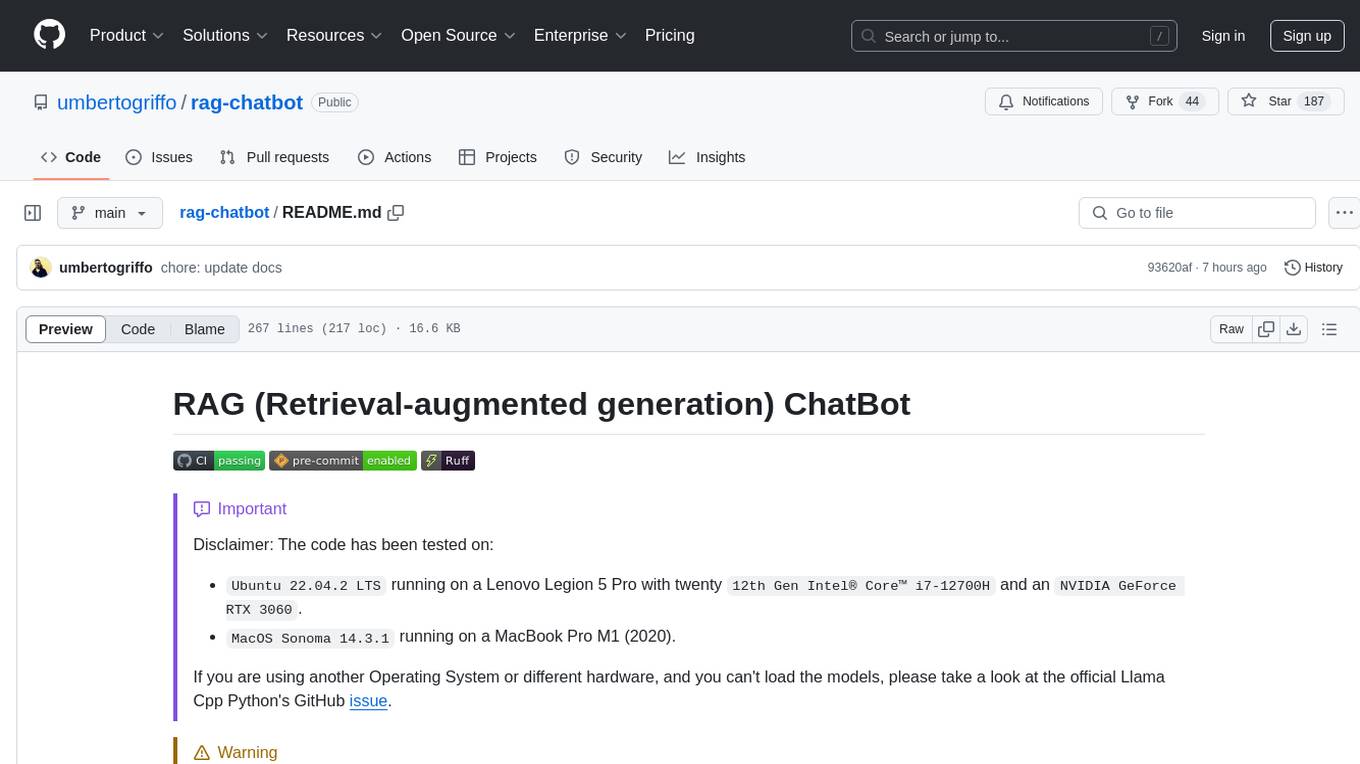
rag-chatbot
The RAG ChatBot project combines Lama.cpp, Chroma, and Streamlit to build a Conversation-aware Chatbot and a Retrieval-augmented generation (RAG) ChatBot. The RAG Chatbot works by taking a collection of Markdown files as input and provides answers based on the context provided by those files. It utilizes a Memory Builder component to load Markdown pages, divide them into sections, calculate embeddings, and save them in an embedding database. The chatbot retrieves relevant sections from the database, rewrites questions for optimal retrieval, and generates answers using a local language model. It also remembers previous interactions for more accurate responses. Various strategies are implemented to deal with context overflows, including creating and refining context, hierarchical summarization, and async hierarchical summarization.
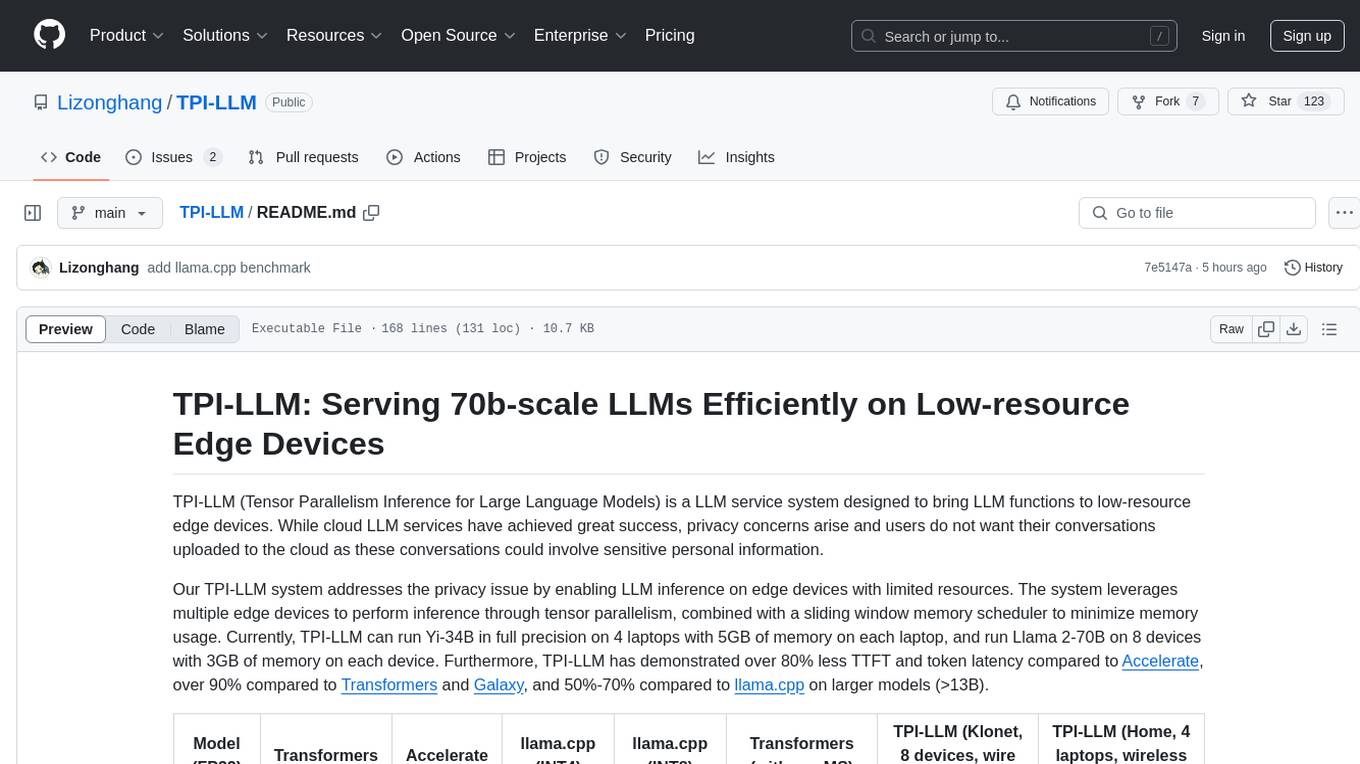
TPI-LLM
TPI-LLM (Tensor Parallelism Inference for Large Language Models) is a system designed to bring LLM functions to low-resource edge devices, addressing privacy concerns by enabling LLM inference on edge devices with limited resources. It leverages multiple edge devices for inference through tensor parallelism and a sliding window memory scheduler to minimize memory usage. TPI-LLM demonstrates significant improvements in TTFT and token latency compared to other models, and plans to support infinitely large models with low token latency in the future.
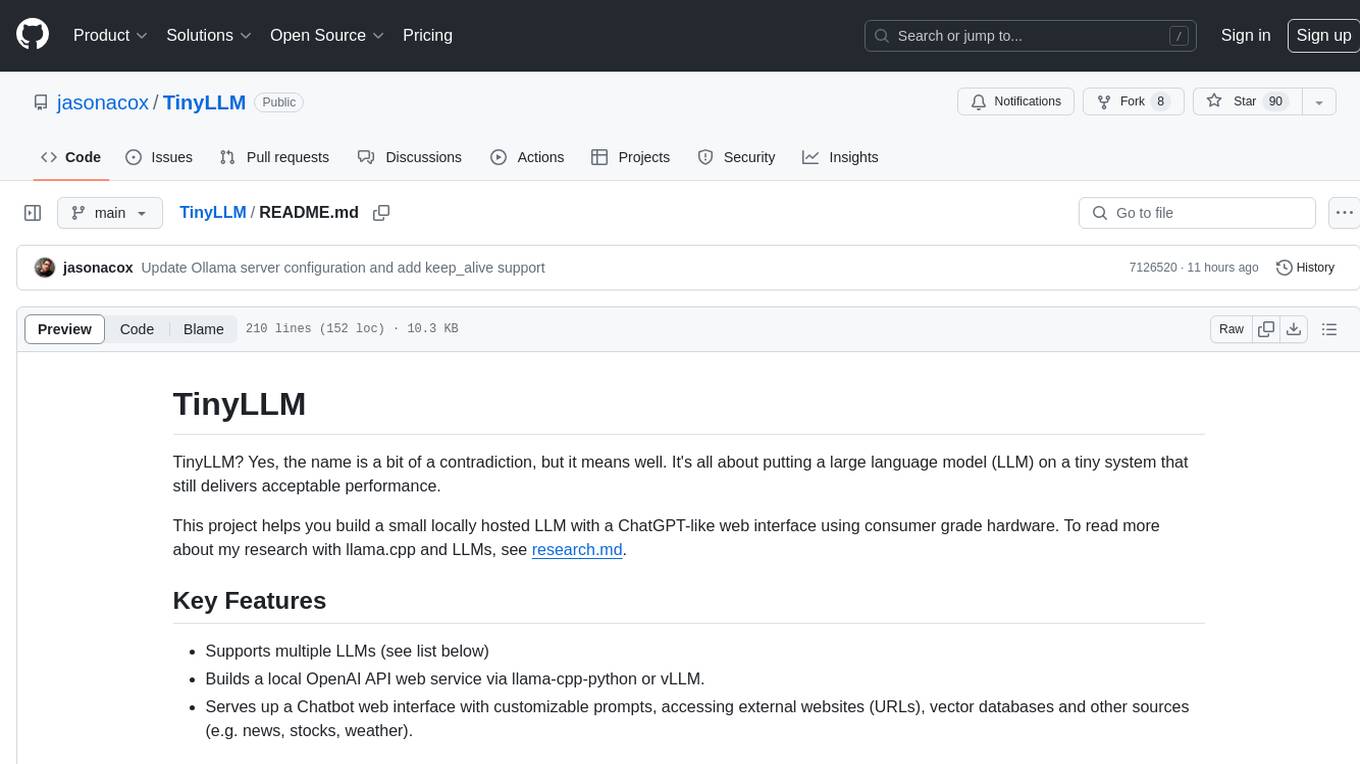
TinyLLM
TinyLLM is a project that helps build a small locally hosted language model with a web interface using consumer-grade hardware. It supports multiple language models, builds a local OpenAI API web service, and serves a Chatbot web interface with customizable prompts. The project requires specific hardware and software configurations for optimal performance. Users can run a local language model using inference servers like vLLM, llama-cpp-python, and Ollama. The Chatbot feature allows users to interact with the language model through a web-based interface, supporting features like summarizing websites, displaying news headlines, stock prices, weather conditions, and using vector databases for queries.
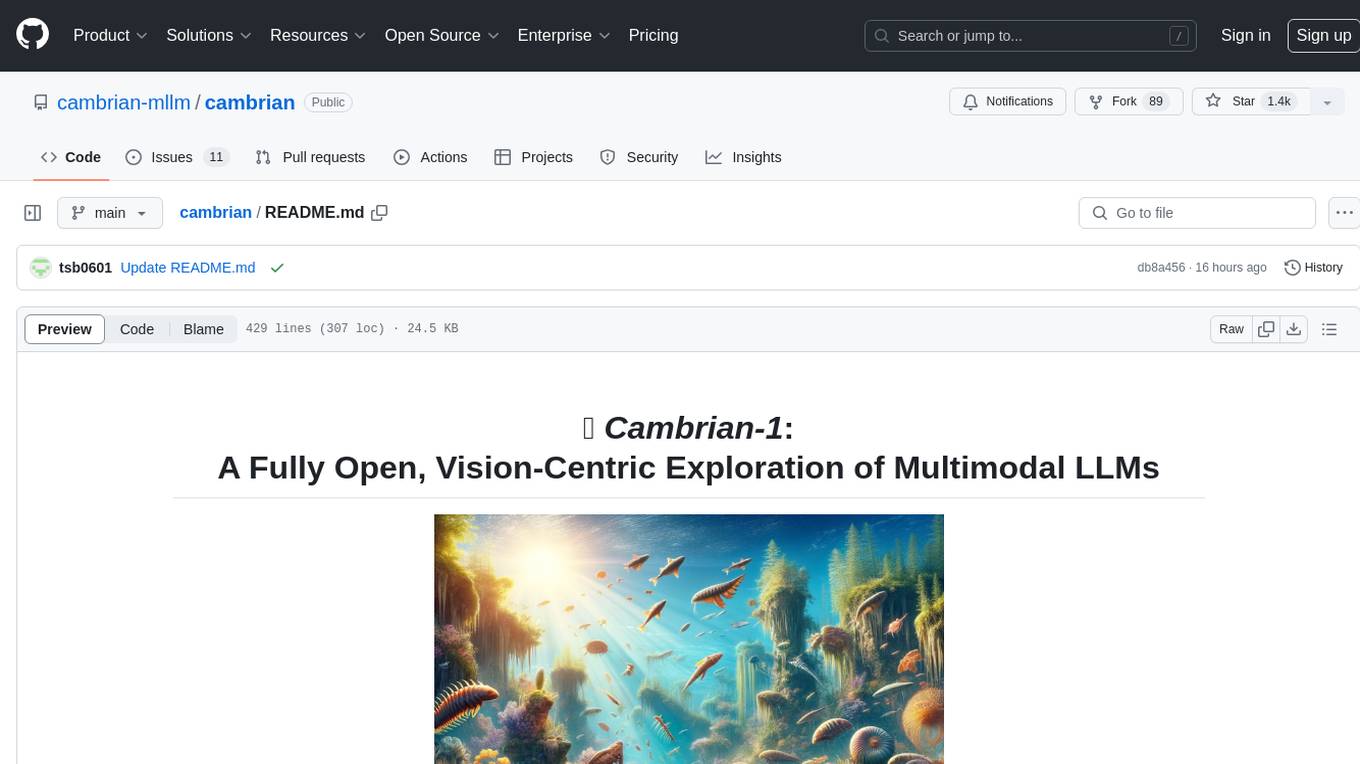
cambrian
Cambrian-1 is a fully open project focused on exploring multimodal Large Language Models (LLMs) with a vision-centric approach. It offers competitive performance across various benchmarks with models at different parameter levels. The project includes training configurations, model weights, instruction tuning data, and evaluation details. Users can interact with Cambrian-1 through a Gradio web interface for inference. The project is inspired by LLaVA and incorporates contributions from Vicuna, LLaMA, and Yi. Cambrian-1 is licensed under Apache 2.0 and utilizes datasets and checkpoints subject to their respective original licenses.
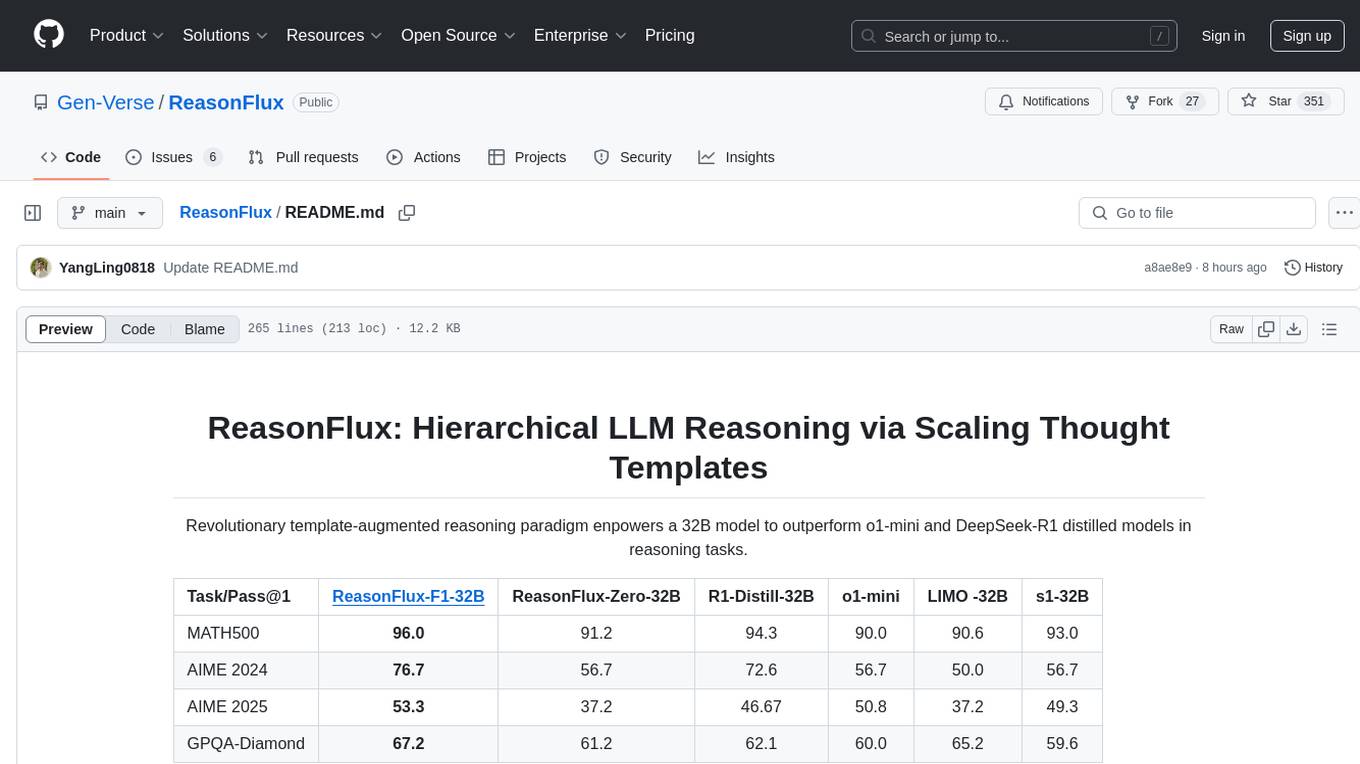
ReasonFlux
ReasonFlux is a revolutionary template-augmented reasoning paradigm that empowers a 32B model to outperform other models in reasoning tasks. The repository provides official resources for the paper 'ReasonFlux: Hierarchical LLM Reasoning via Scaling Thought Templates', including the latest released model ReasonFlux-F1-32B. It includes updates, dataset links, model zoo, getting started guide, training instructions, evaluation details, inference examples, performance comparisons, reasoning examples, preliminary work references, and citation information.
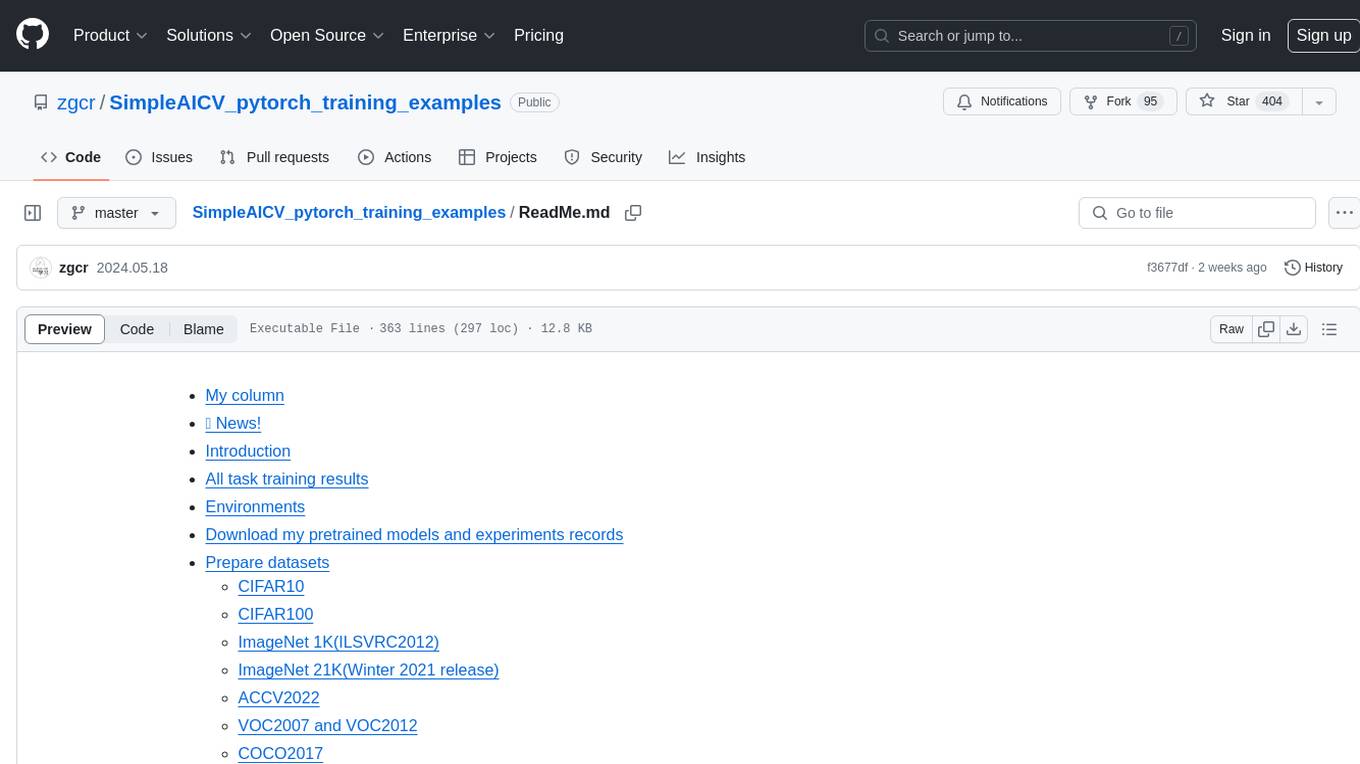
SimpleAICV_pytorch_training_examples
SimpleAICV_pytorch_training_examples is a repository that provides simple training and testing examples for various computer vision tasks such as image classification, object detection, semantic segmentation, instance segmentation, knowledge distillation, contrastive learning, masked image modeling, OCR text detection, OCR text recognition, human matting, salient object detection, interactive segmentation, image inpainting, and diffusion model tasks. The repository includes support for multiple datasets and networks, along with instructions on how to prepare datasets, train and test models, and use gradio demos. It also offers pretrained models and experiment records for download from huggingface or Baidu-Netdisk. The repository requires specific environments and package installations to run effectively.
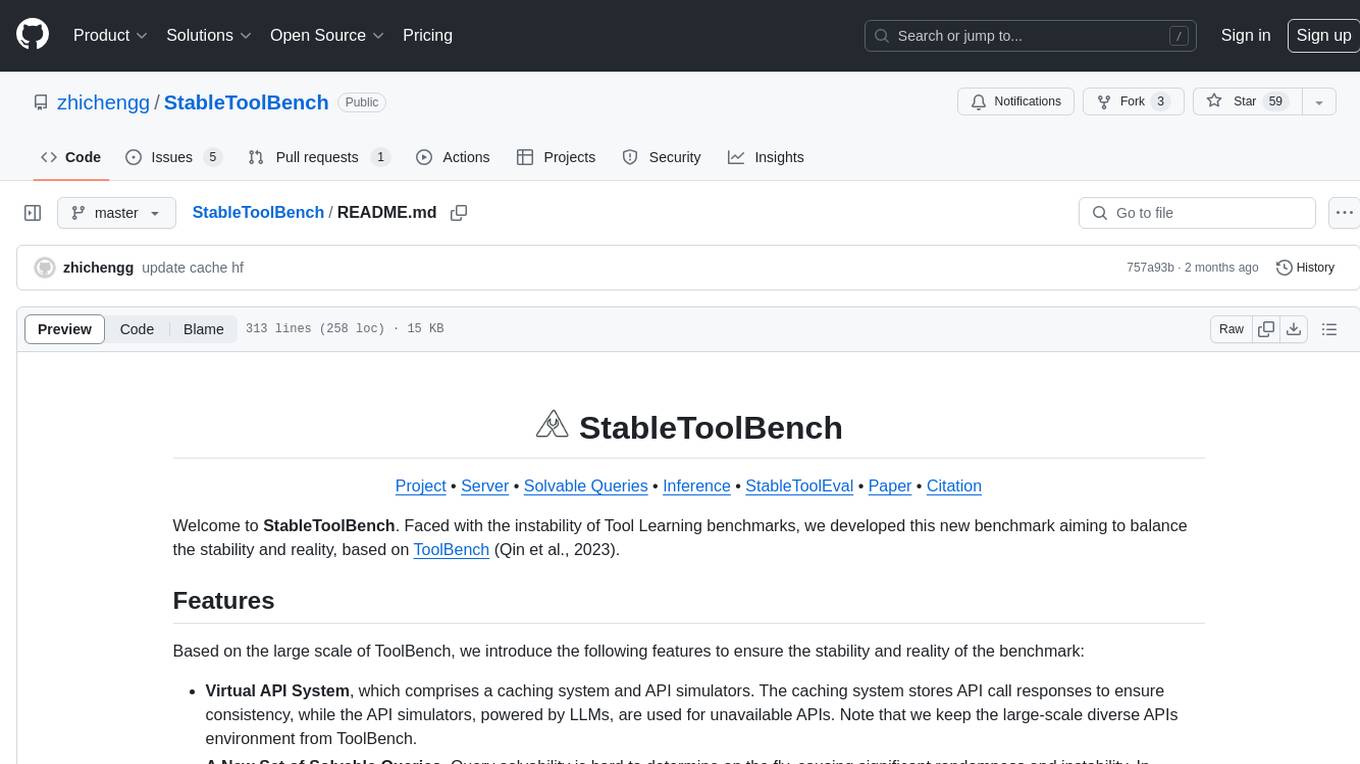
StableToolBench
StableToolBench is a new benchmark developed to address the instability of Tool Learning benchmarks. It aims to balance stability and reality by introducing features such as a Virtual API System with caching and API simulators, a new set of solvable queries determined by LLMs, and a Stable Evaluation System using GPT-4. The Virtual API Server can be set up either by building from source or using a prebuilt Docker image. Users can test the server using provided scripts and evaluate models with Solvable Pass Rate and Solvable Win Rate metrics. The tool also includes model experiments results comparing different models' performance.
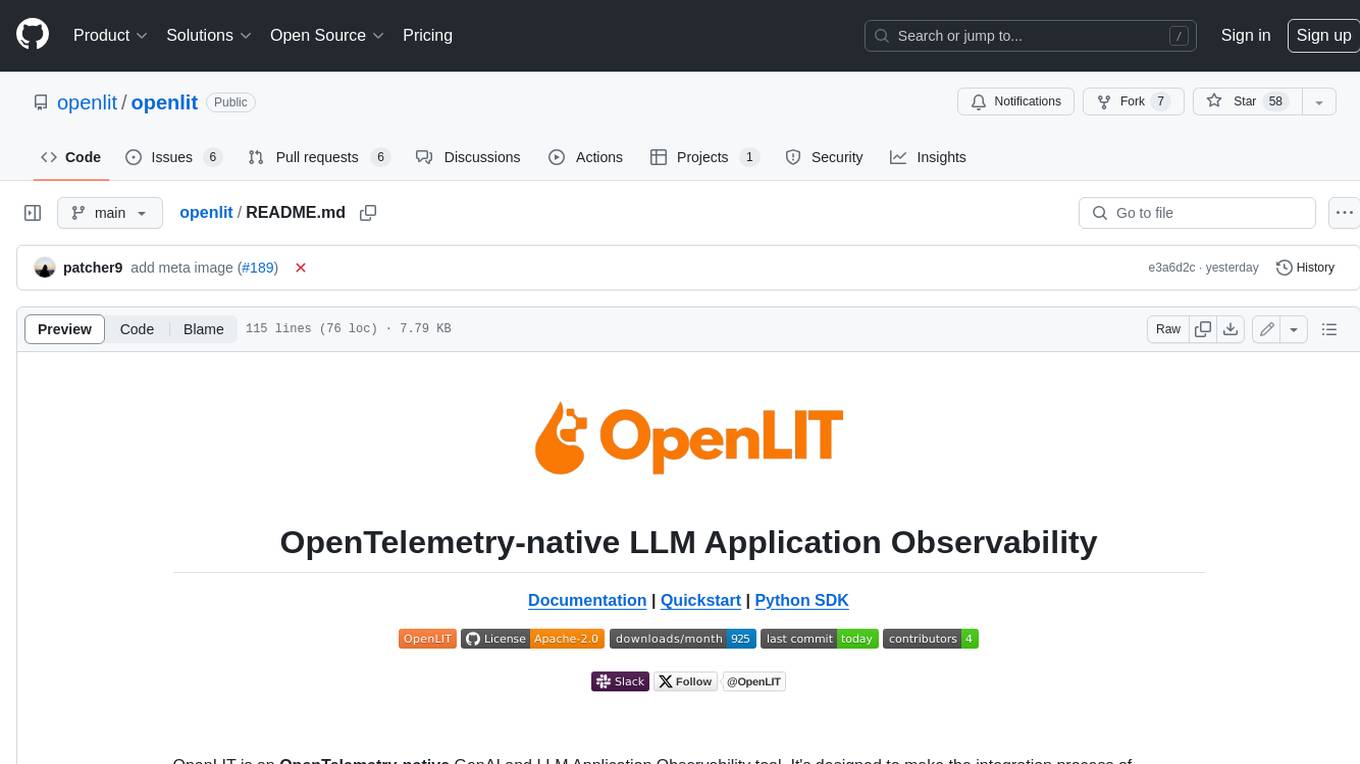
openlit
OpenLIT is an OpenTelemetry-native GenAI and LLM Application Observability tool. It's designed to make the integration process of observability into GenAI projects as easy as pie – literally, with just **a single line of code**. Whether you're working with popular LLM Libraries such as OpenAI and HuggingFace or leveraging vector databases like ChromaDB, OpenLIT ensures your applications are monitored seamlessly, providing critical insights to improve performance and reliability.
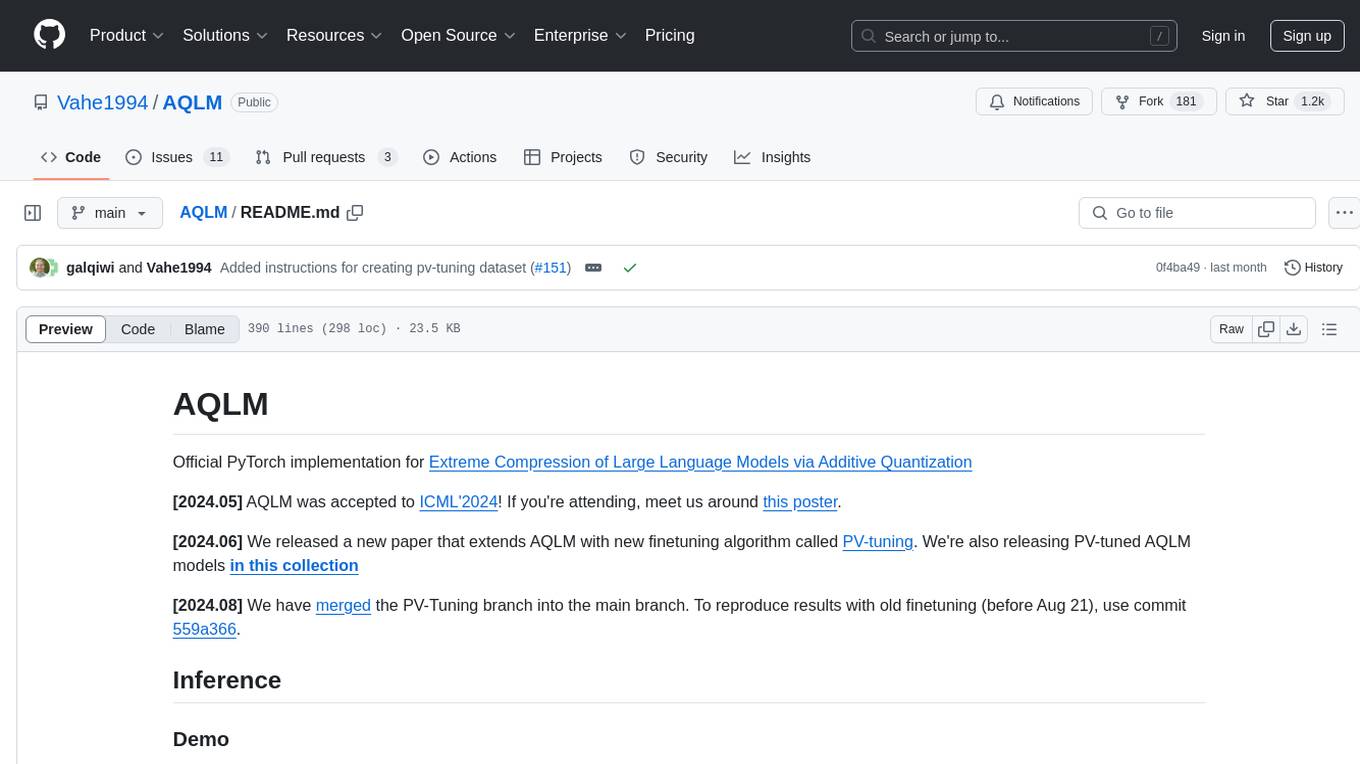
AQLM
AQLM is the official PyTorch implementation for Extreme Compression of Large Language Models via Additive Quantization. It includes prequantized AQLM models without PV-Tuning and PV-Tuned models for LLaMA, Mistral, and Mixtral families. The repository provides inference examples, model details, and quantization setups. Users can run prequantized models using Google Colab examples, work with different model families, and install the necessary inference library. The repository also offers detailed instructions for quantization, fine-tuning, and model evaluation. AQLM quantization involves calibrating models for compression, and users can improve model accuracy through finetuning. Additionally, the repository includes information on preparing models for inference and contributing guidelines.
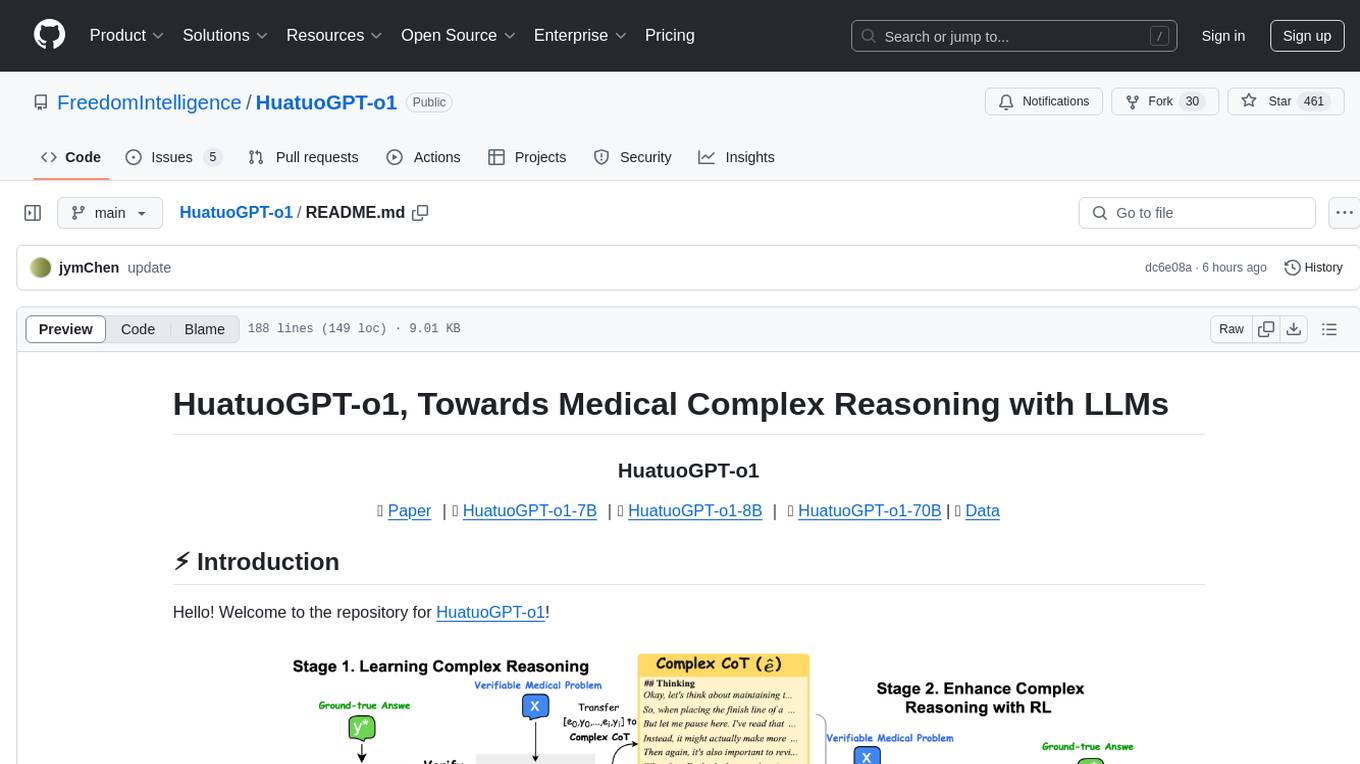
HuatuoGPT-o1
HuatuoGPT-o1 is a medical language model designed for advanced medical reasoning. It can identify mistakes, explore alternative strategies, and refine answers. The model leverages verifiable medical problems and a specialized medical verifier to guide complex reasoning trajectories and enhance reasoning through reinforcement learning. The repository provides access to models, data, and code for HuatuoGPT-o1, allowing users to deploy the model for medical reasoning tasks.
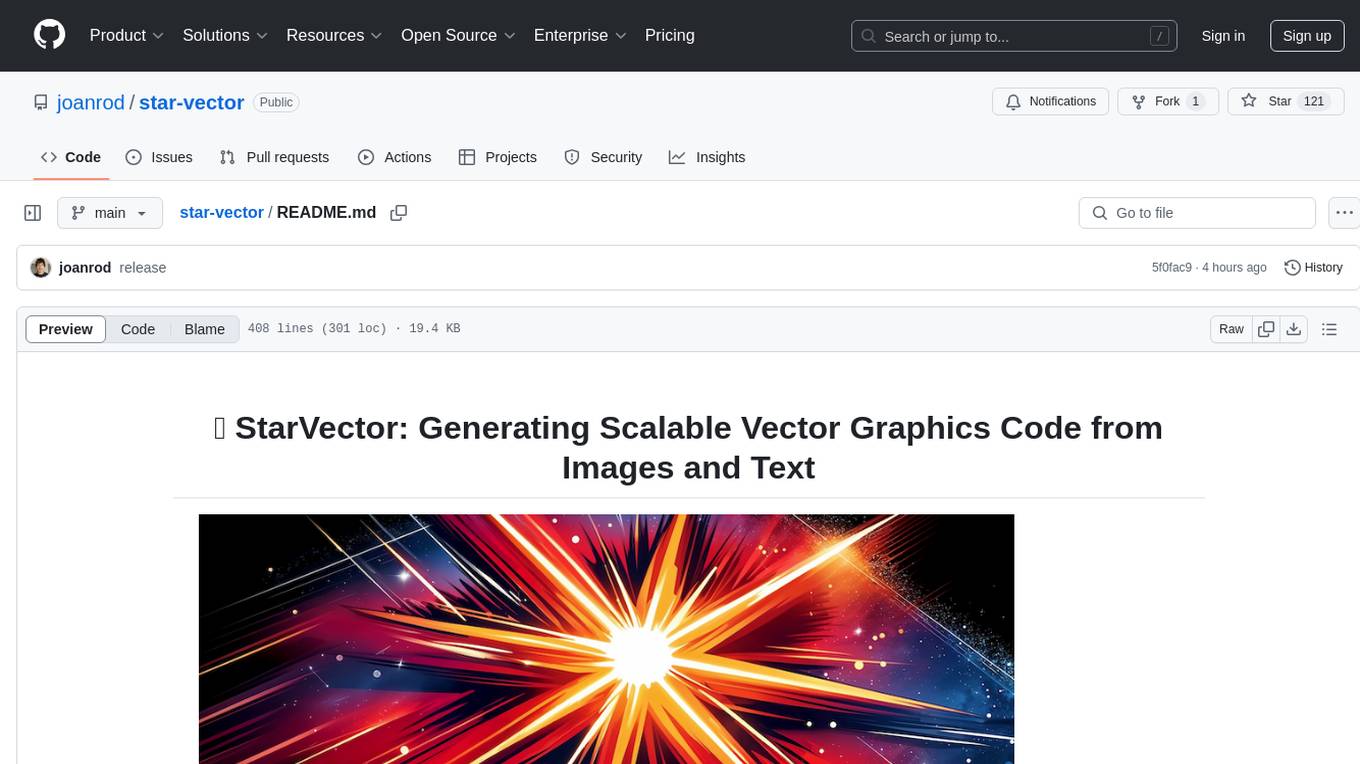
star-vector
StarVector is a multimodal vision-language model for Scalable Vector Graphics (SVG) generation. It can be used to perform image2SVG and text2SVG generation. StarVector works directly in the SVG code space, leveraging visual understanding to apply accurate SVG primitives. It achieves state-of-the-art performance in producing compact and semantically rich SVGs. The tool provides Hugging Face model checkpoints for image2SVG vectorization, with models like StarVector-8B and StarVector-1B. It also offers datasets like SVG-Stack, SVG-Fonts, SVG-Icons, SVG-Emoji, and SVG-Diagrams for evaluation. StarVector can be trained using Deepspeed or FSDP for tasks like Image2SVG and Text2SVG generation. The tool provides a demo with options for HuggingFace generation or VLLM backend for faster generation speed.
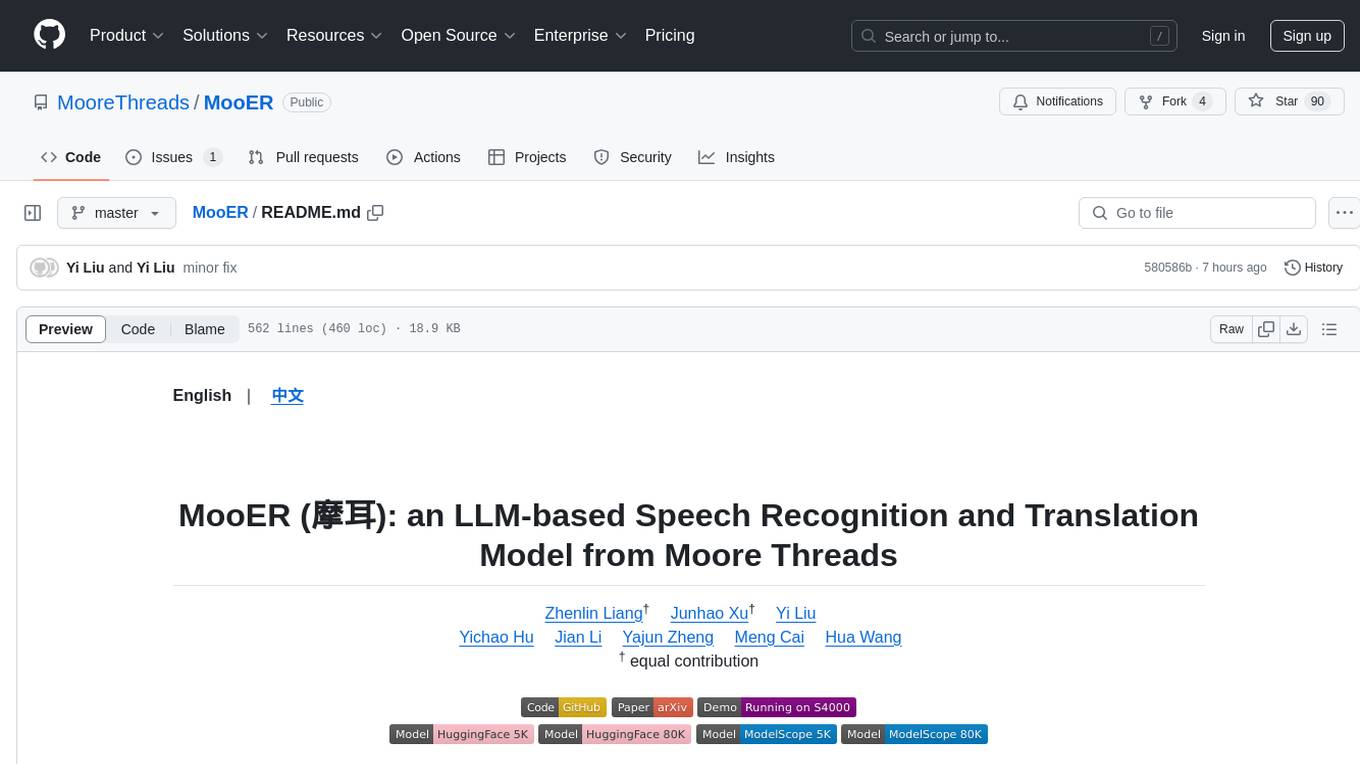
MooER
MooER (摩耳) is an LLM-based speech recognition and translation model developed by Moore Threads. It allows users to transcribe speech into text (ASR) and translate speech into other languages (AST) in an end-to-end manner. The model was trained using 5K hours of data and is now also available with an 80K hours version. MooER is the first LLM-based speech model trained and inferred using domestic GPUs. The repository includes pretrained models, inference code, and a Gradio demo for a better user experience.
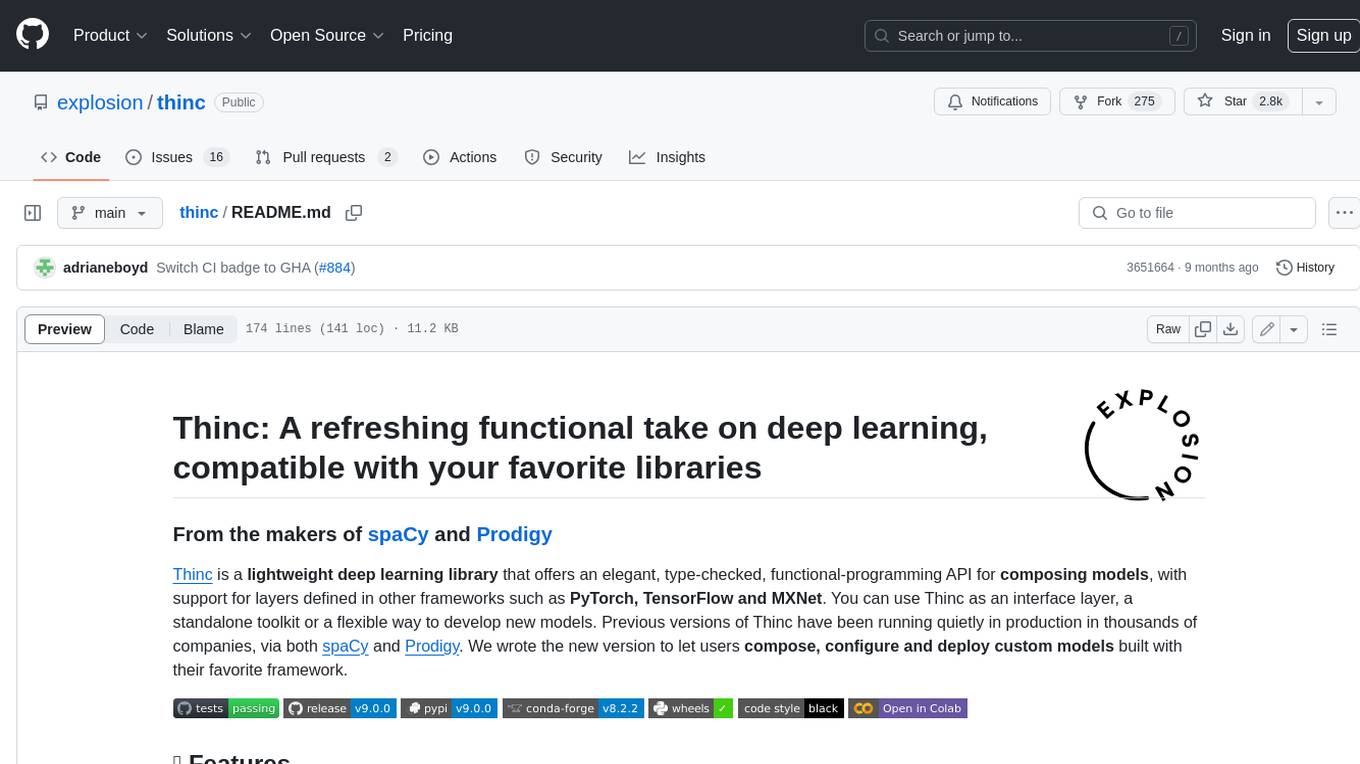
thinc
Thinc is a lightweight deep learning library that offers an elegant, type-checked, functional-programming API for composing models, with support for layers defined in other frameworks such as PyTorch, TensorFlow and MXNet. You can use Thinc as an interface layer, a standalone toolkit or a flexible way to develop new models.
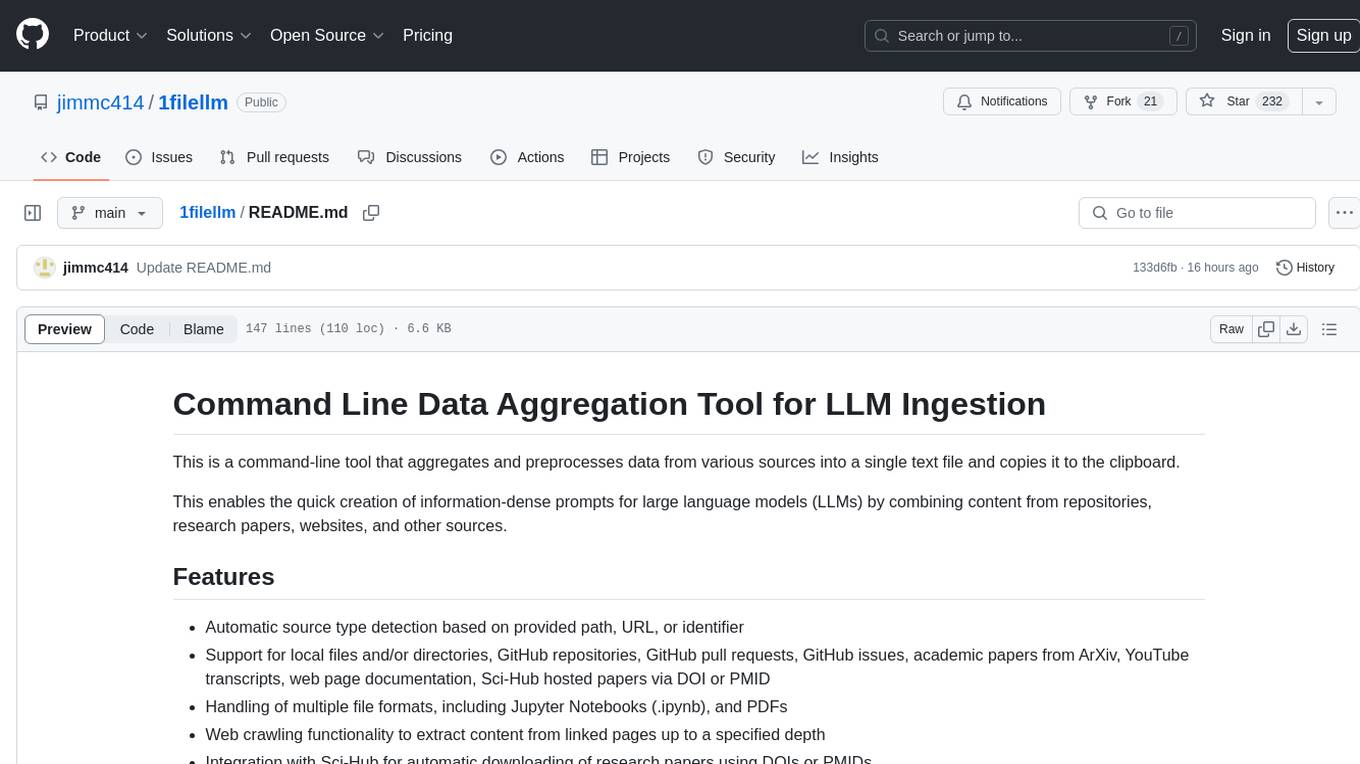
1filellm
1filellm is a command-line data aggregation tool designed for LLM ingestion. It aggregates and preprocesses data from various sources into a single text file, facilitating the creation of information-dense prompts for large language models. The tool supports automatic source type detection, handling of multiple file formats, web crawling functionality, integration with Sci-Hub for research paper downloads, text preprocessing, and token count reporting. Users can input local files, directories, GitHub repositories, pull requests, issues, ArXiv papers, YouTube transcripts, web pages, Sci-Hub papers via DOI or PMID. The tool provides uncompressed and compressed text outputs, with the uncompressed text automatically copied to the clipboard for easy pasting into LLMs.
For similar tasks

clearml-fractional-gpu
ClearML Fractional GPU is a tool designed to optimize GPU resource utilization by allowing multiple containers to run on the same GPU with driver-level memory limitation and compute time-slicing. It supports CUDA 11.x & CUDA 12.x, preventing greedy processes from grabbing the entire GPU memory. The tool offers options like Dynamic GPU Slicing, Container-based Memory Limits, and Kubernetes-based Static MIG Slicing to enhance hardware utilization and workload performance for AI development.
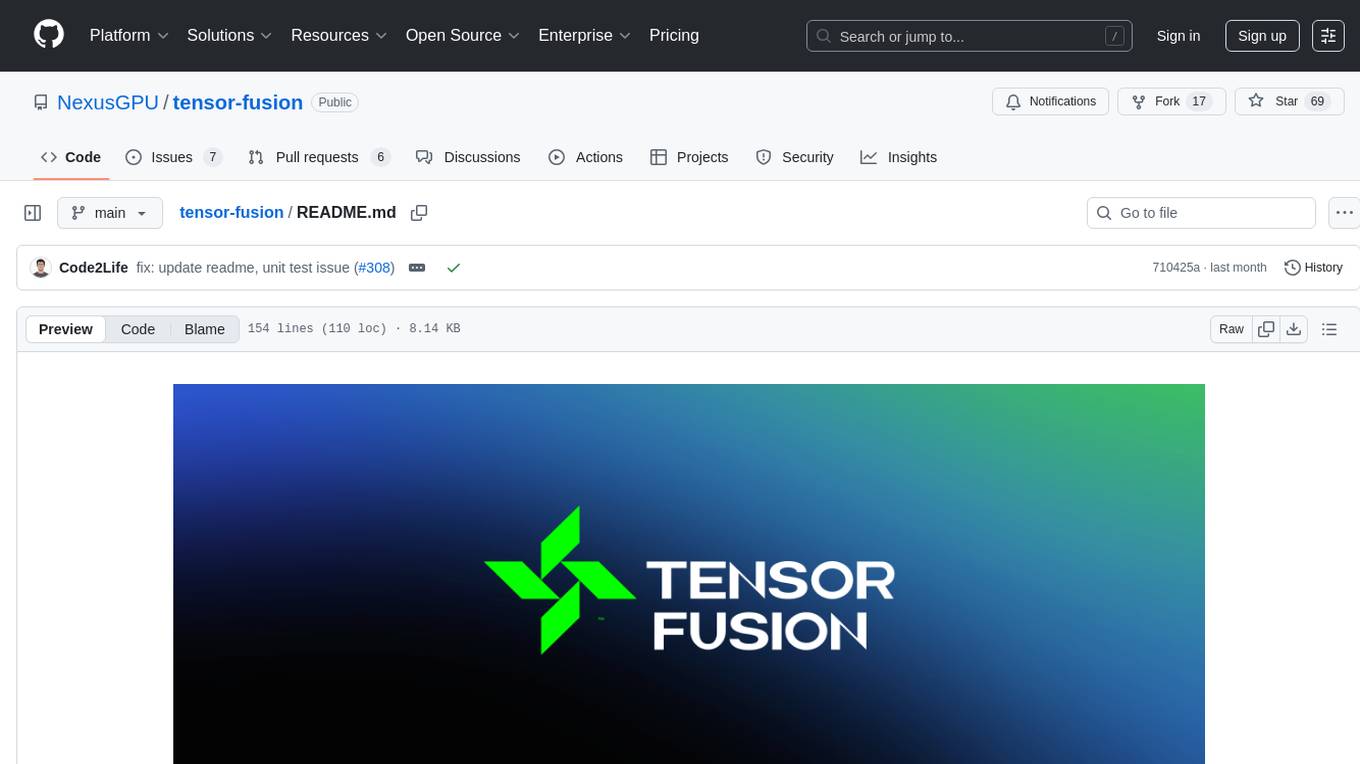
tensor-fusion
Tensor Fusion is a state-of-the-art GPU virtualization and pooling solution designed to optimize GPU cluster utilization. It offers features like fractional virtual GPU, remote GPU sharing, GPU-first scheduling, GPU oversubscription, GPU pooling, monitoring, live migration, and more. The tool aims to enhance GPU utilization efficiency and streamline AI infrastructure management for organizations.
For similar jobs

weave
Weave is a toolkit for developing Generative AI applications, built by Weights & Biases. With Weave, you can log and debug language model inputs, outputs, and traces; build rigorous, apples-to-apples evaluations for language model use cases; and organize all the information generated across the LLM workflow, from experimentation to evaluations to production. Weave aims to bring rigor, best-practices, and composability to the inherently experimental process of developing Generative AI software, without introducing cognitive overhead.

LLMStack
LLMStack is a no-code platform for building generative AI agents, workflows, and chatbots. It allows users to connect their own data, internal tools, and GPT-powered models without any coding experience. LLMStack can be deployed to the cloud or on-premise and can be accessed via HTTP API or triggered from Slack or Discord.

VisionCraft
The VisionCraft API is a free API for using over 100 different AI models. From images to sound.

kaito
Kaito is an operator that automates the AI/ML inference model deployment in a Kubernetes cluster. It manages large model files using container images, avoids tuning deployment parameters to fit GPU hardware by providing preset configurations, auto-provisions GPU nodes based on model requirements, and hosts large model images in the public Microsoft Container Registry (MCR) if the license allows. Using Kaito, the workflow of onboarding large AI inference models in Kubernetes is largely simplified.

PyRIT
PyRIT is an open access automation framework designed to empower security professionals and ML engineers to red team foundation models and their applications. It automates AI Red Teaming tasks to allow operators to focus on more complicated and time-consuming tasks and can also identify security harms such as misuse (e.g., malware generation, jailbreaking), and privacy harms (e.g., identity theft). The goal is to allow researchers to have a baseline of how well their model and entire inference pipeline is doing against different harm categories and to be able to compare that baseline to future iterations of their model. This allows them to have empirical data on how well their model is doing today, and detect any degradation of performance based on future improvements.

tabby
Tabby is a self-hosted AI coding assistant, offering an open-source and on-premises alternative to GitHub Copilot. It boasts several key features: * Self-contained, with no need for a DBMS or cloud service. * OpenAPI interface, easy to integrate with existing infrastructure (e.g Cloud IDE). * Supports consumer-grade GPUs.

spear
SPEAR (Simulator for Photorealistic Embodied AI Research) is a powerful tool for training embodied agents. It features 300 unique virtual indoor environments with 2,566 unique rooms and 17,234 unique objects that can be manipulated individually. Each environment is designed by a professional artist and features detailed geometry, photorealistic materials, and a unique floor plan and object layout. SPEAR is implemented as Unreal Engine assets and provides an OpenAI Gym interface for interacting with the environments via Python.

Magick
Magick is a groundbreaking visual AIDE (Artificial Intelligence Development Environment) for no-code data pipelines and multimodal agents. Magick can connect to other services and comes with nodes and templates well-suited for intelligent agents, chatbots, complex reasoning systems and realistic characters.
